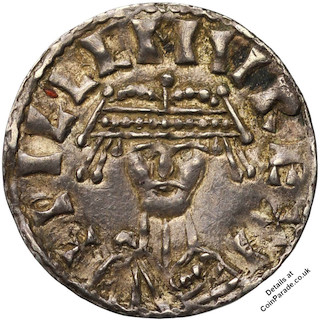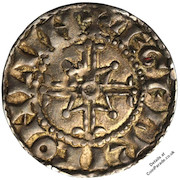
 The 1066 Penny - William I (William the Conqueror) Bonnet Type
The 1066 Penny - William I (William the Conqueror) Bonnet TypeSilver penny of William the Conqueror, struck around 1066 at the London Mint of moneyer Aegelric. Weight 1.3g. SCBC 1251.
The Obverse shows a facing crowned and diademed bust of King William I with two fillets to sides. This is known as the Bonnet Type (BMC 2). Legend "+PILLELMV REXI". Outer beaded.
The Reverse shows Pellet in annulet at centre of short voided cross, terminals of pellet with crescent each sides, pellet topped piles in angle. The legend is the moneyer, '+ÆGELRIC ON LVN'. Outer beaded.
 This coin graded as VF. These coins are rare in this condition and the price will be in the thousands.
This coin graded as VF. These coins are rare in this condition and the price will be in the thousands.Image credit: The Royal Mint
Click to Check these on eBay.
As an eBay Partner, We may be compensated if you make a purchase
(scroll to bottom for more)
As an eBay Partner, We may be compensated if you make a purchase
(scroll to bottom for more)
List items on:
Mintage: Not known
Minted at Provincial mints.
Remember 1066 ?
In Roman numerals as MLXVI. After a 24-year reign, Edward the Confessor dies on January 5. Harold Godwinson becomes King Harold II. In September Harold fights off an invasion by Harald Hardrada of Norway in the North while William the Conqueror builds his invasion force down the South. On October 14 Harold is killed at the Battle of Hastings. Edgar AEtheling is proclaimed King of England (never crowned) but soon concedes and on Christmas Day King William I is the first of the Norman Kings. Halley's Comet appeared and can be seen in the Bayeux Tapestry.
William I (1066-1087)
Classification: House of NORMANDY, NORMAN KINGS.William I, usually known as William the Conqueror, was born about 1028 in Falaise, France. Son of Robert the Magnificent and an unmarried mother, Herleva, he became Duke of Normandy from 1035.
When William's first cousin once removed, Edward the Confessor died, William invaded England, killing King Harold at the Battle of of Hastings on 14 October 1066 and claimed the throne.
As William I he ruled England well although applying high taxation. The Doomsday Book (The 'Great Survey') in 1085 was really a list of land-holdings to see what taxes needed to be paid.
William died on 9 September 1087, aged about 59, at the Priory of Saint Gervase, Rouen, Duchy of Normandy.
Category: Penny
The Penny is one of the most famous British coins. The coin itself has been around since 600AD and at various times has been struck in silver, copper and bronze. Originally split into halfpennies and farthing, it is now itself the least denomination coin currently in circulation. Made from copper (actually copper plated steel). Originally there were 12 pennies in one shilling and 240 pennies in £1; since decimalisation in 1971 there are 100 new pence in one pound.
Composition: Early pennies were Silver, then Copper, Bronze and Copper coated steel.
Which Mint: Provincial mints
Not all mints are located in a single place. From the Roman days through to the middle ages it was easier to have local moneyers (trusted people who were allowed to mint coins) rather than make the coins centrally and then have the security and logistics problem of distribution.There were often dozens of mints, sometimes all making the same coin. The variations and mintmarks are exciting for numismatists, although sometimes it takes an expert to analyse them.
Most English Provincial Mints began to close after 1279 when the Royal Mint opened The Tower Mint (called so as it was housed at the Tower of London), although some continued working for much longer. The central mint gave the King and the Master of the Royal Mint much more control over the production and quality of English coinage.
Country of Origin: United Kingdom
The United Kingdom (UK) is the Union of England, Scotland, Wales and Northern Ireland. It is often refered to as Great Britain (GBR). It has a long, rich history. The orignal coinage was Pounds, Shillings and Pence but since decimalisation on 15 February 1971, it is £1 = 100p, that is One Pound = 100 pence. The coinage of the UK is also a long history, the Royal Mint being established as long ago as 886AD when coins were hammered. Today there is perhaps 30 billion coins in circulation, and many (numismatic) collectors coins and sets are issued frequently in gold, silver and other metals.
If you don't see a coin in the list below try the Penny page on eBay UK
As an eBay Partner, We may be compensated if you make a purchase.
As an eBay Partner, We may be compensated if you make a purchase.
List items on:
List items on:








